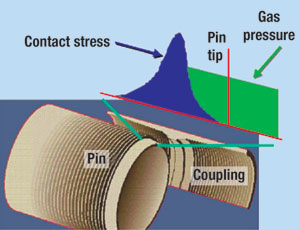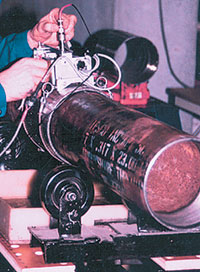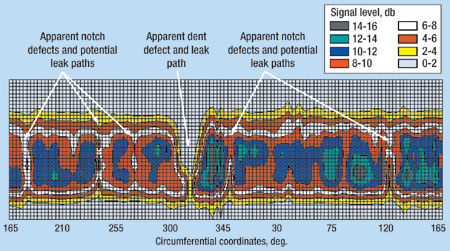Technology at Work: Assessing tubular connection leakage integrity
Feb. 2002 Vol. 223 No. 2 Feature Article TECHNOLOGY AT WORK Assessing tubular connection leakage integrity Cam Matthews, C-FER Technologies Casing / tu
TECHNOLOGY AT WORKAssessing tubular connection leakage integrityCam Matthews, C-FER Technologies Casing / tubing strings used in almost all oil/gas wells employ threaded connections which are expected to provide both structural and leakage integrity under service loads. The risk of a casing or tubing string leak increases with well depth, i.e., number of connections; and a significant leak from even a single connection can constitute a completion failure. Connection leakage or failures can lead to serious economic / safety consequences, including: sustained casing gas pressure; exposure of unprotected equipment to corrosive fluids; external pressure buildup leading to casing collapse; and abandonment concerns. These problems are most critical in HPHT / sour wells; and offshore platform or subsea wells. As loading conditions associated with deeper, more hostile well environments have increased tubular string performance requirements, many operators switched from using standard API connections, i.e., 8-rd or buttress thread profiles, to premium connections. Whereas the sealing of API connections relies on thread compound blockage of the inherent helical leak path through the threads, premium connections incorporate mating seal surfaces in pin / box components which are pre-stressed during make-up to provide a direct seal mechanism. There is a wide range of premium connection products currently available for different well applications, although designs vary considerably and are typically proprietary. Seal performance. While premium connections usually offer enhanced structural capacity with tensile / compressive load limits that exceed the pipe body itself, structural and leakage integrity are generally independent of one another. Seal performance of a premium connection is tied to presence of a narrow band of high contact stress, typically a few millimeters wide, on the seal surface after make-up. In general, the band of high contact stress must be continuous around the full connection circumference, and peak contact-stress magnitude must exceed, by at least several times, the pressure differential the connection will be exposed to in service to ensure minimal leakage.
Peak magnitude / distribution of the contact stress profile can be influenced by several factors, including design, geometric tolerances, make-up torque / turns, coatings, thread compound type / volume, galling and seal-surface damage. Further, downhole axial, bending, pressure differential, and thermal loads can reduce pre-stress magnitude and, thus, enhance leakage potential. During installation of casing or tubing, adequate seal performance is usually inferred based on assessment of make-up data – i.e., torque vs. turns results – within a framework established on past experience and, perhaps, some specific qualification testing. A few companies also offer connection testing services, in which individual connections are subjected to a short internal gas pressure test after make-up. However, this generally assesses seal integrity only indirectly, with respect to long-term service under downhole conditions. URAP technology. C-FER Technologies of Edmonton, Alberta, has developed a more direct approach for assessing premium-connection seal integrity. The patented technology known as Ultrasonic Reflection Amplitude Pressure (URAP*) is based on the principle of using pulsed ultrasonics to measure contact pressures between mating solid surfaces, wherein a thin, liquid "squeeze film" is trapped in the interfacial region. The technique relies on the ability to measure reflection amplitude of a high-frequency, acoustic pulse returned from the mating interface film. In the case of premium connections, an ultrasonic signal beamed at the thread-compound film trapped in the seal region will be partially transmitted across the interface and partially reflected. As contact pressure between mating seal surfaces increases, a greater proportion of acoustic energy is transmitted through the interface and the proportion reflected diminishes. Therefore, in simple terms, the reflection amplitude of the URAP signal is inversely related to contact pressure (stress) under these conditions.
Using a special jig, the technique can be employed to obtain either qualitative or quantitative measurements of contact stress in tubular connections, Fig. 2. For a qualitative assessment, the system simply records attenuation of the reflection signal amplitude from scans taken before and after make-up to obtain a relative measure of contact stress. Scans taken at different locations on the contacting surfaces are then mapped and compared on a magnitude basis to understand the contact stress distribution. To obtain quantitative measurements, the correlation between reflection signal amplitude and contact stress magnitude must be pre-determined using a special calibration system. Various parameters associated with the calibration tests, e.g., thread compound, surface finish, must match those of the connection being evaluated for the measurements to be interpreted in terms of actual stress. Connection assessment results. Since the technology was first developed several years ago, C-FER has used it extensively in both lab and threading mill evaluations of various premium connections. For qualification test programs, URAP scans of test specimens on initial make-up directly assess whether the design intent has been achieved. In some programs, initial URAP results identified specimens which would most likely have failed the tests due to a discontinuous contact stress band or overall low peak contact-stress. Early identification of the problematic specimens led to significant cost savings associated with execution of the respective test programs. Coupled with non-linear finite-element analysis methods, URAP measurements thus offer connection developers a unique means to assess connection behavior as a function of design / make-up parameters and to verify satisfactory seal performance under a variety of load conditions. In mill applications, the technique has been used successfully as a tool for verifying seal integrity of mill-end connection make-ups. It has served to confirm adherence to acceptable machining tolerances and achievement of a proper make-up condition in the connections evaluated. In a recent blind test, a major operator submitted a 31_2-in. integral joint tubing specimen to C-FER for analysis. The operator had introduced a number of undisclosed "flaws" on the seal surface prior to make-up, and the purpose of the test was to determine whether URAP could identify their presence. Fig. 3 shows the contact-stress map established, based on measurements taken over the seal surface region. The technique successfully identified low-stress regions at all of the subsequently disclosed flaw locations.
The flaws ranged from a slight hammer blow to the pin, i.e., at 315°, to a very narrow (0.5-mm), shallow (0.13-mm), machined groove across the seal at 180°. These results confirm the direct correlation between URAP signal attenuation and contact-stress magnitude and clearly demonstrate the exceptional flaw-detection capabilities of the technology. Next step: Rig floor make-up assessments. The next logical step for the technology is rig floor use as a make-up, quality-assurance method to identify connections with inadequate pre-stress due to tolerance issues, defects or insufficient make-up torque or rotation. In rig-floor applications, URAP-scan results would be analyzed immediately on-site, allowing the operator to make real-time decisions whether seal make-up specs have been met and, if not, the problem source would be identified and action taken. Two field trials completed previously in Canada using prototype equipment were successful in demonstrating the significant potential for use in this application. C-FER is currently pursuing industry partners for completion of development work on a robust commercial scanning system designed for taking fast, accurate measurements on the rig floor. The initial target market is offshore and critical well applications where achieving improved well completion reliability has huge cost impacts. Bibliography Matthews, C. M., "Do you sleep well at night knowing your premium connections are leak tight?" Proceedings, CADE / CAODC Drilling Conference, Calgary, Alberta, October 2001. |
- What's new in production (February 2024)
- Prices and governmental policies combine to stymie Canadian upstream growth (February 2024)
- U.S. operators reduce activity as crude prices plunge (February 2024)
- U.S. producing gas wells increase despite low prices (February 2024)
- U.S. drilling: More of the same expected (February 2024)
- U.S. oil and natural gas production hits record highs (February 2024)
- Applying ultra-deep LWD resistivity technology successfully in a SAGD operation (May 2019)
- Adoption of wireless intelligent completions advances (May 2019)
- Majors double down as takeaway crunch eases (April 2019)
- What’s new in well logging and formation evaluation (April 2019)
- Qualification of a 20,000-psi subsea BOP: A collaborative approach (February 2019)
- ConocoPhillips’ Greg Leveille sees rapid trajectory of technical advancement continuing (February 2019)





